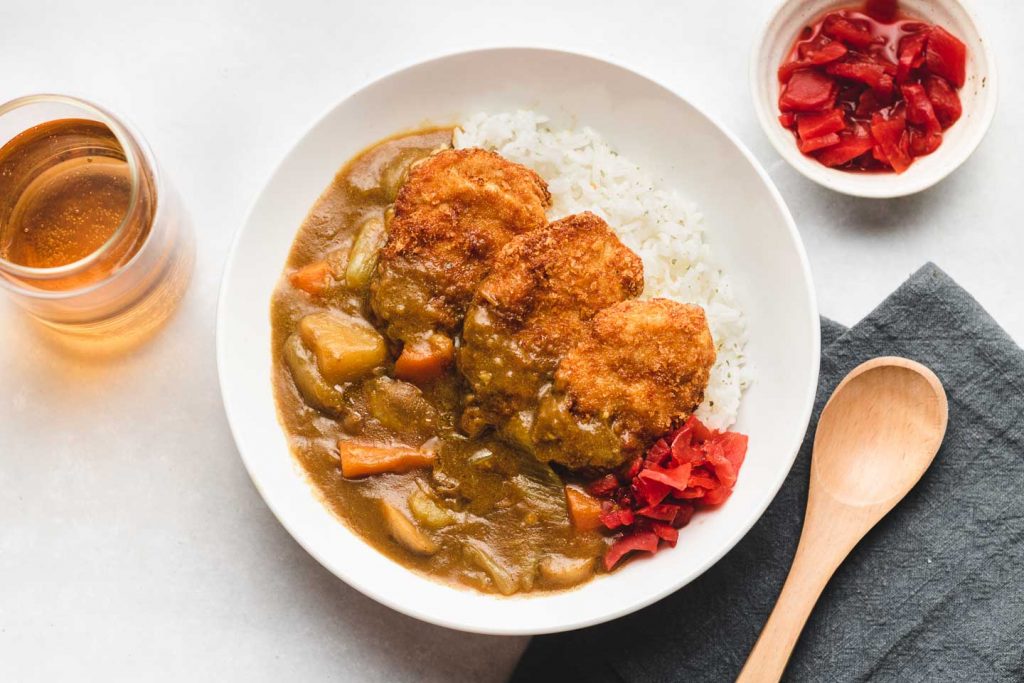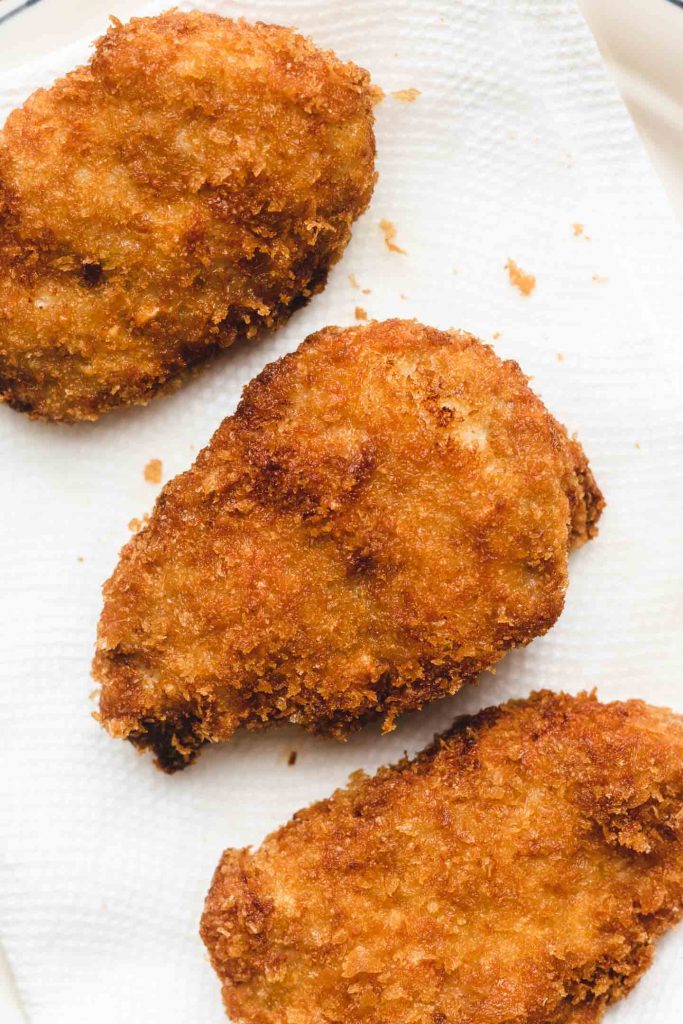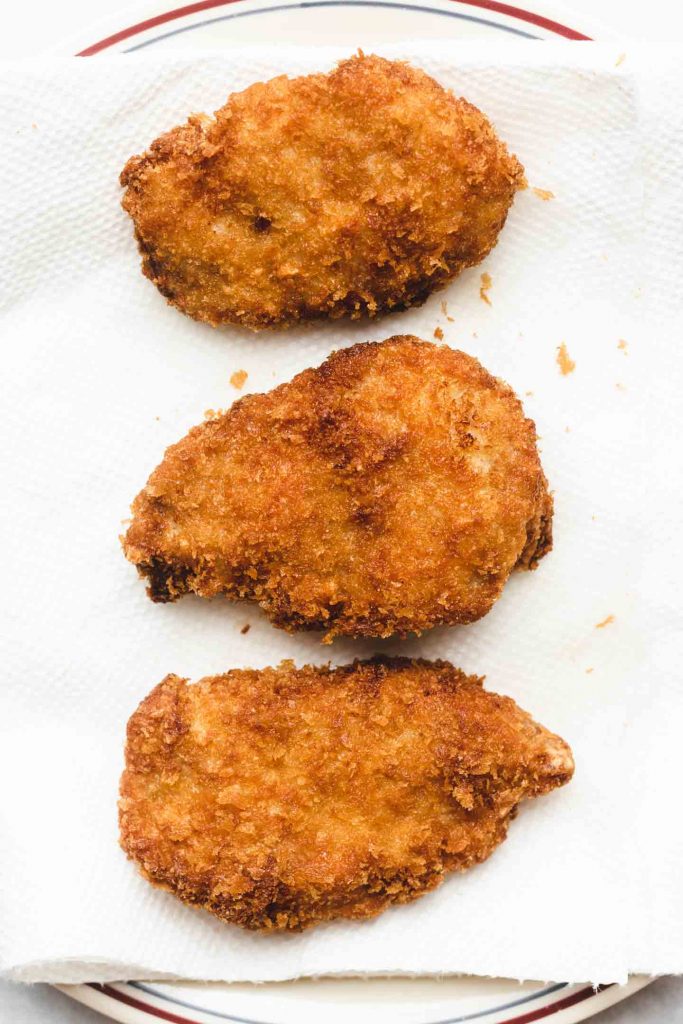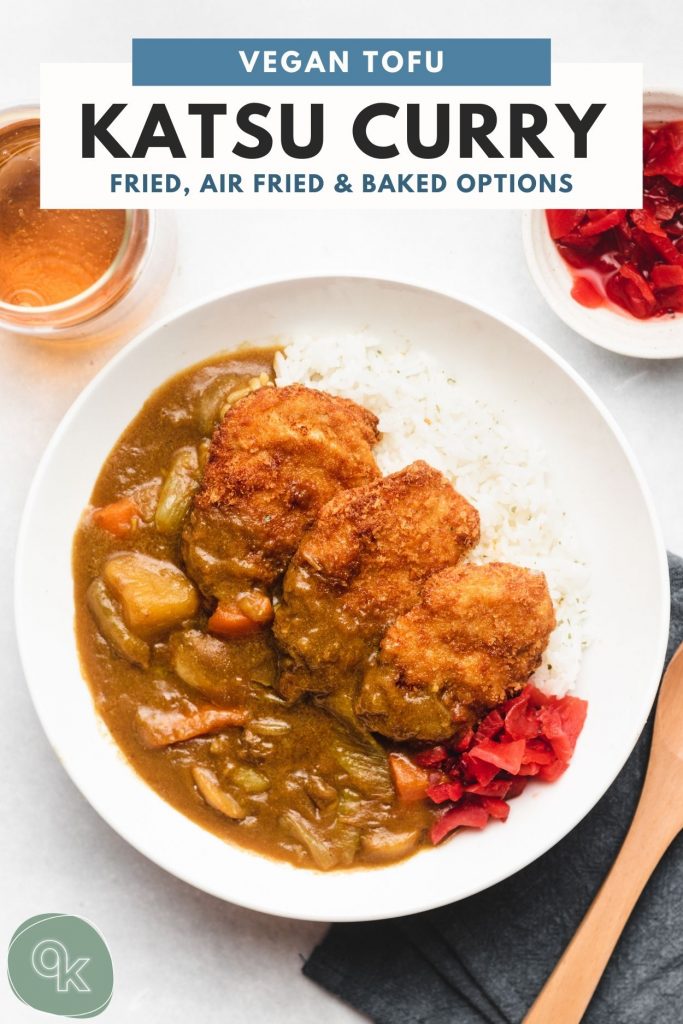
This Vegan tofu katsu thats perfectly crispy served with rice and rich Japanese curry for the ultimate comfort meal! This vegan katsu curry is easy to make and easy to make and make ahead friendly, too. (Gluten free option).

Katsu and curry and two national home comfort dishes in Japan. And when you take two comfort foods and put them together, you’re left with the ultimate hearty, satisfying and incredibly delicious meal.
What is katsu curry?
Katsu Curry (カツカレー) is Japanese curry topped with a light and crispy panko-breaded is a combination of Japanese Curry and a panko-breaded cutlet. In Japan, curry is a frequent dinner of choice because of how quick, easy and make-ahead friendly it is. However, adding katsu to it makes it extra special (in our family, we only had it for special occasions).
The combination of a crispy crunchy cutlet mixed with a rich and flavourful curry sauce.. you really just gotta try it to experience the magic.
Vegan Katsu Curry
Katsu is typically made from pork or chicken cutlets but tofu is my favourite option for a vegan and vegetarian version. It’s the perfect substitute because of how meaty the texture is and how easily you can make it look like real cutlets too!

Katsu tofu ingredients
To make vegan katsu curry, you’ll need one recipe of Japanese curry and rice. For the katsu, you’ll need:
- Tofu: There are many varieties to choose from so this is really preference (see more info on the type of tofu below).
- Potato starch or flour
- Egg or egg replacer: As an egg replacer, you can choose between a very thick aquafaba, a combination of water and potato starch or non-dairy yogurt. My personal favourite that I think yields the best results is the aquafaba or yogurt mix
- Oil: For deep frying and also adding it into the egg mixture. My grandpa actually taught me this trick and said that it was his secret way to prevent the breading from coming off when frying.
- Panko: Japanese breadcrumbs are key to a really good katsu! Do not use regular bread crumbs.

Types of Panko Breadcrumbs
Even within panko, there are different types. The two brands shown above are my preferred brands that look like the bottom left. The bottom right is the Kikkoman brand.
- Shape: Authentic panko have a long and sharp shape vs. panko that are round in shape.
- Size: Authentic panko are very random in size and range from large to medium size vs. the round panko that are mostly similar in size. Variation of sizes also provide a nicer appearance after being fried.
- Taste: Japanese brand panko tend to have a ever so slight sweetness and salted cracker-like flavour vs. the taste of regular breadcrumbs (bread-y flavour).
- Texture: Authentic panko have a lighter and airy texture vs. a hard-crunchy texture.
Panko breadcrumbs should never be hard or dense. Only a truly authentic Japanese Panko will give your menu items a delicate, light and crispy texture without a heavy oily taste.
In addition to the light delicate texture, an Authentic Japanese Panko also meets the popular demand for clean and GMO free ingredients your customers want. No preservatives, dough conditioners or any flavor enhancers.

How to make vegan tofu katsu curry
There are three components to katsu curry:
- Curry: Choose between a diner style smooth curry like my Coco Ichi-style Curry or family style Vegetable Japanese Curry with chunks of vegetables. I highly recommend making the curry the night before or earlier in the day so that the flavours have time to mature and mingle together.
- Katsu: There are several types of tofu you can choose from to make tofu katsu such as yuba, traditional tofu, medium firm tofu, firm tofu and extra firm tofu (more info below). Choose whatever you like! You can also opt to air fry or bake instead of deep fry.
- Rice: Cook the rice about one hour before serving.

Preparing the vegetables
If making family style curry, you can choose to cut the vegetables smaller so that it kind of breaks down into the curry. I personally still like to have chunks of veggies in my curry if making family style, but experiment and see which you like better
What type of tofu should I use?
This really depends on what kind of texture you’re going for. If you like the texture of tofu as it is, choose between yuba, traditional soft, medium firm, firm or extra firm. I don’t recommend using silken or soft (unless double frozen and thawed) because they are much more fragile to work with.
How to prepare the tofu
It’s important to draw excess moisture out of the tofu before frying to prevent it from exploding. There are several ways to do this:
- Press the tofu: using a tofu press or balancing a heavy object on top of the tofu with a towel wrapped around it.
- Soak in salted water: pour salted water over the tofu and let it sit for 8-10 minutes. The salted water will draw the moisture out of the tofu.
- Freeze & Boil: Place a block of frozen tofu in boiling salted water over a simmer for 10 minutes.
- Microwave: If using fresh tofu, microwave on medium (600 W) with a paper towel wrapped around it for 1-2 minutes. If using frozen, microwave on medium for 4 minutes until defrosted.
How to make meaty tofu
If you prefer katsu tofu with a meat-like texture, there are two ways to do this:
- Double Freezing #1: Works best with traditional soft or medium firm tofu, as mentioned in my air fryer tofu recipe. Simply freeze the entire block of tofu, thaw and press. Then freeze again, thaw and press. If you want to go beyond that, a third freeze makes extra tight flakey layers.
- Double freezing #2: You may also press, freeze, thaw, press, freeze, thaw and press.

How to cut the tofu
Again, there are several ways you can do this:
- Cutlet: Slice the tofu into widths of 1/2 an inch. It doesn’t have to be completely flat, having a bit of grooves makes it looks more realistic if you’re going for that look. Then cut the corners off. For a true cutlet like appearance, round out the corners with a pair of scissors. No need to be perfect with the cuts! The less perfect it is, the more it looks like a real cutlet.
- Nuggets: Slice the tofu into 4 squares. You can use the tofu as is or cut them into irregular shapes like (kinda like larger nuggets). Then season the tofu pieces with salt and pepper on both sides.

Dredging tofu
Have three shallow dishes or prep pans out. Add potato starch or flour to one, egg replacer (yogurt or aquafaba) in another and panko in the third. Additionally, you can have one more on the side to place the breaded tofu.

How to cook tofu katsu
There are three methods of making tofu katsu: fried, air fried and baked.
First, prepare three shallow bowls and fill one with flour, another with aquafaba (+ the oil) and the third with panko.
Dredge the tofu in flour and shake off any excess flour. Dip into the aquafaba. Then dredge into the panko making sure you have an even coating all around.
Deep frying / pan frying
- Add oil to a heavy bottom pot about 1 1/2 inches in height. Heat over medium-high. I like to start frying at 320 F because it makes for a more even and golden exterior. If you want to pan shallow fry, add enough oil to cover the pan and then fry each side over
- Place 1-2 pieces of the katsu (do not over-crowd) into the oil and deep fry for 1-2 minutes without moving it. Once golden, carefully flip and cook for another 2-3 minutes until golden.
- Carefully remove the katsu with tongs or chopsticks and place onto a wire rack or paper towel lined plate to remove excess oil.
How to know the oil is ready to fry
There are three ways to check:
- Thermometer: the easiest and most accurate
- Chopsticks: Place chopsticks into the oil and if you see small bubbles on the tip, then you’re ready to fry.
- Panko: Add a piece of panko to the fryer. If it sinks and pops back up, then it’s ready to go.
Air frying
- Follow the steps from above but instead of deep frying, air fry at 375 F. I highly recommend spraying the air fryer basket and tofu katsu with oil to get a more ‘fried’ texture. Air fry for about 6-8 minutes or until light golden brown. Flip and air fry for another 5 minutes or until golden brown.
Baking
- Follow steps 1-3 from above.
- We are also going to be pre-toasting the panko for a better crunchy crust. Add the panko to a pan over medium heat and spray with oil. Cook until lightly golden brown and then remove to the third bowl. Then do the dredge, dip and dredge.
- Place the katsu pieces on a prepare oven safe wire rack or baking sheet and bake at 400 F for 10-12 minutes on each side or until golden brown.
Now that we have all three components ready, place some rice into a bowl and then add 2-3 pieces of tofu katsu. Then pour over the curry. Add some fukushinzuke to the side and enjoy!

Quick & easy with left overs
Making katsu kinda sounds like a lot of work. You gotta cook the rice, the curry AND the katsu but, it’s actually very quick and easy to make if you’re efficient with your time (aka multi-tasking). To make it even faster, you can use leftover curry!
I’ll purposely make extra curry and tofu katsu to keep in the fridge or freezer. And then when I feel like katsu curry, I’ll make the katsu fresh (from frozen) and then serve it with warmed up left over rice and curry. It takes me under 15 minutes to put together.
How to store curry
Curry will keep in the fridge for 3-4 in the fridge and up to 1 month in the freezer. Be sure to remove the potatoes from the curry if freezing because when thawed, they tend to become soggy-spongy in texture.
To reheat
To reheat, you may need to add some water to get a smooth consistency because it will thicken as it cools.
- Microwave: Do it in 30 second intervals, stirring each time until heated.
- Stove top: Let the curry thaw first and then add to a pot over medium low heat. Once it starts to heat up, bring heat down to low to keep it warm.
How to store tofu katsu
Tofu katsu will keep in the fridge for 2-3 days. To reheat, place in toaster oven or oven at 350 F until warmed and crispy again. Do not microwave or the katsu will get soggy.
You can also freeze tofu katsu! I’ll always make a double batch just to keep in the freezer for quick meals. You can either freeze it before frying or after frying. Place un-fried katsu on a baking sheet and freeze. Once frozen keep in freezer safe containers. If after frying, let it cool completly and then place in the freezer for up to 1 month. When ready, let the tofu katsu thaw and then fry. If pre-fried, reheat in the oven at 350 F for 10-15 minutes or until warmed and crispy again.

More vegan curry recipes to try:
- Authentic Vegan Japanese Curry
- Japanese curry powder
- Japanese kabocha curry
- Homemade curry roux cubes
- Yaki Curry (coming soon)
- Curry udon
- Curry fried rice
SAVE IT FOR LATER! ↓

If you recreate this Vegan Tofu Katsu Curry recipe let me know how you liked it by leaving a comment and rating below or by tagging me on Instagram @Okonomikitchen, I love seeing all of your tasty recreations!
Hungry for more? Be sure to subscribe to my newsletter and follow along on Instagram, Youtube and Pinterest for more deliciousness!

Tofu Katsu Curry (Vegan)
- Total Time: 0 hours
- Yield: 3 servings 1x
- Diet: Vegan
Description
Crunchy tofu katsu served with white rice and a rich Japanese curry sauce! So hearty, flavourful and is truly the ultimate comfort dish. (Vegan + Gluten free option)
Ingredients
Curry
- 1 recipe of Vegan Japanese Curry: Diner style (smooth sauce) or Family style (chunks of vegetables)
Tofu Katsu
- 1 block (350 – 450 g) tofu of choice (see details about tofu selection in the blogpost)
- 3 tbsp all potato starch or flour
- 1/4 cup non-dairy yogurt or aquafaba
- 2 tsp oil, optional
- 1 cup panko (Japanese bread crumbs)
- salt
- pepper
For serving
- cooked rice
- fukushinzuke
- ryakyo
Instructions
Curry
- Prepare one batch of curry, preferably the night before or earlier in the day to allow flavours to mature and mend together.
Katsu Tofu
- Choose method of preparing and pressing the tofu (see blogpost for details). I’m using traditional / medium firm tofu and have froze, thawed and pressed it twice. If using firm or extra firm, freeze overnight and thaw in the fridge. Press any excess moisture out. If pressed for time, you may press firm or extra firm tofu for a minimum of 20 minutes to remove any excess moisture. You can do this with a tofu press or by placing a flat object (like a cutting board) on top with a heavy object on top of that.
- For one regular sized cutlet, slice the block of tofu into 1/2 inch width pieces (I’m able to get 3 per block of tofu). Then cut off the corners and shape as desired. For mini cutlets, slice the block of tofu into 4. You can use the tofu as is or cut them into irregular shapes to make them look more like nuggets.
- Line up 3 shallow bowls. Add the potato starch to one, yogurt to the next and panko to the third. Add the oil to the yogurt or aquafaba bowl and stir (if using- this helps prevent the panko from detaching when frying). If using a thick yogurt, add a little water to thin it out a bit.
- Pat the tofu dry with a lint free towel or paper towel. Sprinkle a bit of salt and pepper to each side. Coat in potato starch and then the yogurt on both sides and all the edges. I find using a fork makes this process much easier and less messy. Then press it into the panko, ensuring you get a nice even coat on each side and around the edges. Gently shake off any excess panko. Repeat for remaining pieces.
Deep Fry
- Add oil to a heavy bottom pot about 1 1/2 – 2 inches in height. Heat the oil over medium high heat and wait until the oil is heated to 180 C / 350 F. If you don’t have a thermometer, add a piece of panko to the oil, if it floats up then it’s ready to start frying.
- Place 1-2 pieces of the katsu into the oil and deep fry for a few minutes (about 1 – 1/2 minutes) without moving it around. When it gets golden brown, carefully flip it over and cook for another 2-3 minutes until golden brown.
- Remove the katsu with tongs or chopsticks and then place on a paper-lined wire rack or plate. Repeat until all of them are fried
Air fried
- Follow steps 1-4 from above. Pre-heat air fryer to 375 F. Spray the air fryer basket and katsu with oil (optional, but will make them more crispy and ‘fried’). Place the tofu katsu into the basket and air fry for about 6-8 minutes or until light golden brown. Flip and air fry for another 5 minutes or until golden brown.
Baked
- Follow steps 1-3 from above. Pre-heat oven to 400 F. Place a oven-safe wire rack onto a baking sheet (or parchment paper).
- In a pan over medium heat, add the panko and spray with oil. Cook until golden brown. Remove from heat and add to the third bowl. Then follow step 4 from above.
- Place the tofu katsu onto the wire rack and bake for 10-12 minutes on each side or until golden brown.
To serve
- Add cooked rice to a shallow bowl along with the curry. Top with katsu and enjoy!
Notes
- Helpful Equipment: temperature thermometer
- Nutritional Information Disclaimer: Nutrition information is a rough estimate calculated on an online tool (Cronometer).
- Prep Time: 30 minutes
- Cook Time: minutes
- Category: Entree
- Method: Deep frying
- Cuisine: Japanese
Nutrition
- Serving Size: 1 serving
Okonomi Kitchen is a participant in the Amazon Services LLC Associates Program. When you purchase something through my amazon affiliate links, I earn a small commission that helps me produce consistent content at no cost to you. Thank you for supporting my plant based kitchen!











I used regular medium firm tofu /pressed for 30 mins (I forgot to freeze my tofu) and followed the recipe and still turned out really good!
Ps.make sure to cook lots of rice cause you will come back for more
I made this last night and it was sooo good! I didn’t get all the moisture out of the tofu before freezing it (oops!) but it still came out just fine. My boyfriend even asked what kind of meat it was!
I used the air fry method, and I didn’t use enough oil which meant it didn’t get as dark as I wanted on the first go. My second batch browned much more nicely with more oil. But it cooked all the way through in the time listed on the recipe! It was crispy and delicious and everything I wanted in a katsu!! 😀
I made this last night and it was sooo good! I didn’t get all the moisture out of the tofu before freezing it (oops!) but it still came out just fine. My boyfriend even asked what kind of meat it was!
I used the air fry method, and I didn’t use enough oil which meant it didn’t get as dark as I wanted on the first go. My second batch browned much more nicely with more oil. But it cooked all the way through in the time listed on the recipe! It was crispy and delicious and everything I wanted in a katsu 🙂
Thanks for sharing this recipe and for all the preparation instructions, I used the Press, freeze & freeze technique, and now I always have a tofu in the freezer.
The tofu katsu came out amazing! I never breaded anything with aquafaba before so I’ve even learned something new here 🙂
This recipe was excellent, thank you! The tofu Katsu was the most successful breading/ frying recipe I’ve ever used… and I’ve been vegetarian for almost 15 years, so I’ve made a lot of tofu! The curry was just like from our favorite Japanese restaurant. I added the soy sauce and cocoa for hidden flavors and will try others next time I make this to experiment.
This is so good! I made the curry powder yesterday and then made this today (airfried tofu version). It’s so so good. Thank you!
Yum yum yum!!!! I’ve always been too lazy to make the katsu but if you have the time definitely do it! This was so delicious thank you so much for your recipes!
Thank you for trying this recipe Samara! So happy to hear it was a hit!
I made this using the oven method, and for a no-oil method, the resulting texture was really interesting! It was so satisfying to be able to cook this at home this easily.
Like an other commenter, I also swapped out some key ingredients (potato starch instead of the cornstarch listed here as an aquafaba alternative) but the result turned out really OK (even though the panko didn’t stick that much at first).
I also enjoyed learning about the freeze and boil method to “dry” the tofu!
Thanks for trying this recipe, Sylvain! Glad it worked out for you in the end 🙂
Even though I chose to be cheap and swap out some key ingredients (cornflakes are definitely not the same as panko), it still came out great and really tasty and crunchy. This was also my first time pressing tofu using the freeze and boil method, so I really appreciate the instructions on how to do so. Great for beginners!
So happy to hear you enjoyed this recipe, Gina! Thanks so much for the review 🙂